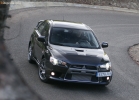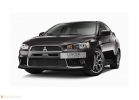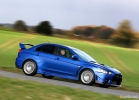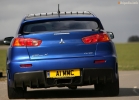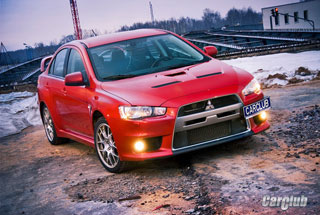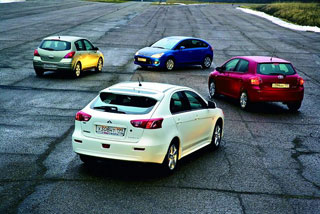Mitsubishi Lancer Evolution X test drive since 2008 sedan
Test drive Mitsubishi Lancer Sportback Ralliart. Europe chooses sports hatchi
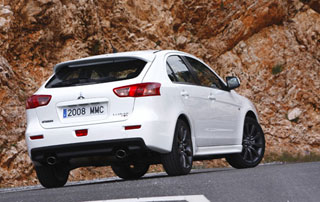 The passion of Europeans for sports hatchbacks originated at least 30 years ago with the advent of Volkswagen Golf GTI. Hot hatchback (as it is commonly called in the UK) is a supercar for everyone, an object of lust. The sedan is the destiny of the elderly and uncertain, so there is nothing surprising in the fact that only 30% of Britain sales account for full -size sedans with 4 doors.
The passion of Europeans for sports hatchbacks originated at least 30 years ago with the advent of Volkswagen Golf GTI. Hot hatchback (as it is commonly called in the UK) is a supercar for everyone, an object of lust. The sedan is the destiny of the elderly and uncertain, so there is nothing surprising in the fact that only 30% of Britain sales account for full -size sedans with 4 doors. Even Mitsubishi describes the new Mitsubishi Lancer Sportback Ralliar as the most European Mitsubishi. This is a direct opponent of the latest Golf GTI models and, most importantly, Subaru Impreza WRX. The car will go on sale in Europe this fall, but for now it’s still very vague, there are rumors that sales of this model in the USA are also possible.
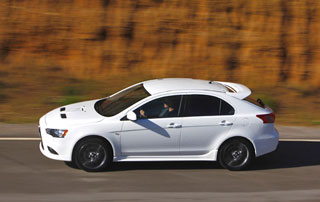 Unexpected changes
Unexpected changes We are so accustomed to the unique Lancer silhouette in the sedan body that Mitsubishi Lancer Sportback Ralliart at first glance seemed strange to us that two different cars decided to collect together in Mitsubishi. But, having taken a few steps back and examining the car again, you understand that this is actually a sample of a harmonious, perfectly executed design.
Specialists of the European design center Mitsubishi worked on the appearance of this model, and the result is very reminiscent of the 2005 Concept-Sportback concept. The length of the body is 4,585 mm, which is 1.5 cm larger than that of the Ralliart sedan, although a completely different impression is visually added. The angular rear of Sportback and the small rear window make this car visually smaller than it really is.
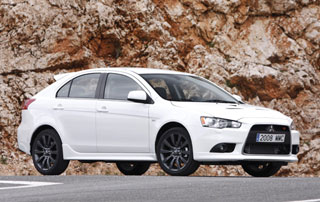 Europeans are accustomed to focus on the Ford Focus standard with three doors; The 4-door Golf GTI and Opel Astra find similarity to the proportions of the new Sportback, although at the same time the machine managed to maintain the proprietary Lancer features. In particular, the front part, with a variety of ribs and lines, looks very aggressive and very Japanese.
Europeans are accustomed to focus on the Ford Focus standard with three doors; The 4-door Golf GTI and Opel Astra find similarity to the proportions of the new Sportback, although at the same time the machine managed to maintain the proprietary Lancer features. In particular, the front part, with a variety of ribs and lines, looks very aggressive and very Japanese. Yes, and Ralliart is called the younger Evo in Europe for a reason: you feel the extensive experience of mitsubishi participation in the rally. The British branch of Mitsubishi is so concerned that buyers can prefer the version of the Ralliart more advanced EVO that they even decided not to import a sedan from Ralliarity into the country. The meaning of the undertaking is simple: if you dream of Evolution, you will have to part with a tidy sum.
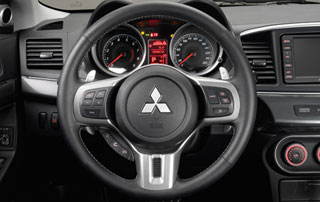 And what's inside?
And what's inside? There is nothing to tell about the salon. To the rear rack, he did not undergo any changes, so we see the same practical and at the same time attractive sedan. The only object of our criticism was the lack of sports seats in the tested car, because leather seats, of course, look very good, but they do not provide side support.
Europeans value the hatchback configuration for its versatility both when traveling to rest and for the transport of a large family. Sportback is even more universal in this regard than its analogue in the sedan body. And although the stylistic solution of the back of the car negatively affected the capacity of the luggage compartment (there are 342 liters of baggage, which is an average indicator in this class of cars), with folded rear seats, the volume of the luggage compartment still increases to 1,393 liters.
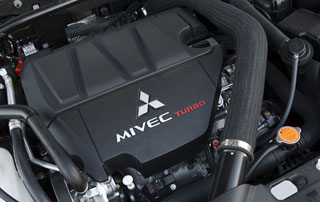 Most delicious
Most delicious Ralliart power unit makes this car a lightweight version of EVO. A completely aluminum 2.0-liter, in-line 4-cylinder engine with a DOHC system resembles the one that is installed in EVO, only turbines here are smaller and simpler. The main requirement was the simplicity of power control, which, with 291 hp, which was not easy to use, has a decreased to 237 hp. At 6,000 revolutions per minute, and torque decreased from 406 nm to 339 nm, available in the range from 2,500 to 4,000 revolutions per minute.
These indicators are not at all random. It allow models from Ralliart to go around Subaru Impreza WRX (224 hp and 306.4 nm) and rivals from Europe, such as the VW Golf GTI Edition 30 (226 hp and 299.6 nm). At the same time, however, Sportback is heavier than the Lancer Sedan by 20 kg, but if you compare it with Subaru, then for all 100 kg. This understands more than modest acceleration from a place to hundreds, which is 7.1 s, which the manufacturer speaks of, although a two -disc clutch dictating its conditions can play a positive role here (for comparison, recently we were able to disperse the Ralliart sedan from 0 to 100 km /hour for 6.8 s).
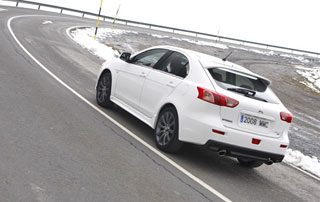 The sound of this engine and the sensations that he gives can only be obtained from a turbocharged 4-cylinder in-line unit from Japan. He has such an angry sound that seems to speak about how much he tries, even at idle. He is no longer as evil as the 291-horsepower unit from Evo, and you catch yourself on the fact that you press the gas on the floor. To our taste, this is an overly lightweight version of EVO.
The sound of this engine and the sensations that he gives can only be obtained from a turbocharged 4-cylinder in-line unit from Japan. He has such an angry sound that seems to speak about how much he tries, even at idle. He is no longer as evil as the 291-horsepower unit from Evo, and you catch yourself on the fact that you press the gas on the floor. To our taste, this is an overly lightweight version of EVO. But this reduction in power is not so acute thanks to the excellent Mitsubishi transmission: Twin-Clutch Sequential Sportshift Transmission (TC-SST two-disc sequent sports transmission). This device is also borrowed from Evolution (although without a start control system), and it works with amazing smoothness. You can choose between the standard operating mode of Drive and the automatic Sport mode, or go to manual speed switching mode, in this case, switching is carried out using steering wheel petals. In sports mode, you can spin the engine up to the cut -off, and switching down is excessively sharp, which can be somewhat tedious. If you want an aggressive driving, it is better to use the manual mode.
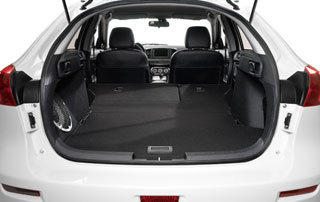 Light on hatche
Light on hatche You should not get carried away here. Ralliart is controlled not as good as Evo. Despite the presence of an active central differential, Ralliart lacks the contrastial system AYC (Active Yaw Control), which provides EVO excellent stability at high speeds. You can go quickly, but on this machine a high speed will require you to more perfect driving skill.
Ralliart has more insufficient rotation than the older brother: the other is the reason for the weight distribution of the axes (60% in front, 40% SPAM) and the softer suspension, which also provides more demolition in corners than could be expected. This Sportback Ralliart feels best in long smooth turns, where it can show itself in all its glory. Complex sharp turns are best left to be densely knocked down EVO.
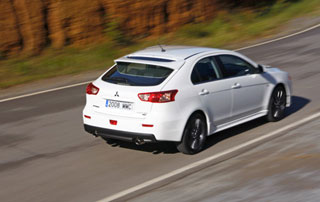 Nevertheless, at high speeds, Ralliart Sportback feels excellent. It is also pleasant to manage them, at least we liked to ride it along the roads of Spain, where the test was passed. On uneven asphalt, you begin to rejoice at a soft suspension, which makes the car not so capricious. The steering is as balanced and pleasant as you expect this (not as acute as EVO), the brakes were also pleased: we did not feel changes in their work even after several hours of hard drive along the Catalunya WRC rally highway.
Nevertheless, at high speeds, Ralliart Sportback feels excellent. It is also pleasant to manage them, at least we liked to ride it along the roads of Spain, where the test was passed. On uneven asphalt, you begin to rejoice at a soft suspension, which makes the car not so capricious. The steering is as balanced and pleasant as you expect this (not as acute as EVO), the brakes were also pleased: we did not feel changes in their work even after several hours of hard drive along the Catalunya WRC rally highway. There is nothing to complain about, except for the too annoying sound of the transmission switching at high speeds. Ralliart Sportback is suitable for daily trips even more than EVO. However, you will have to get used to the smell of dressings, since we managed to devastate the tank for 241 km.
Hot hatchback or lightweight EVO?
If you perceive Mitsubishi Lancer Sportback Ralliart as an inexpensive way to get into the EVO world, then you may be disappointed. If you want a thrill, it is better to purchase a used EVO for about the same amount.
But those who need a quick roomy car for the real world with a certain share of the EVO-reality, RallIart will be able to offer a lot. And you prefer you Sportback or the sedan matter of taste. The sedan is more like a real EVO, and Sportback is more universal and unlike. Let's hope that the US motorists will have a choice.
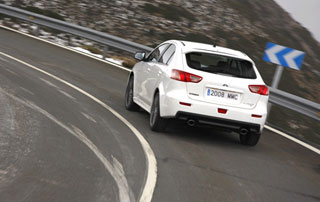
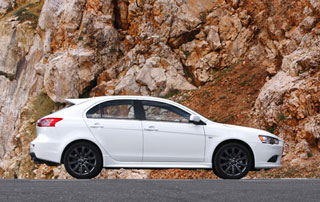

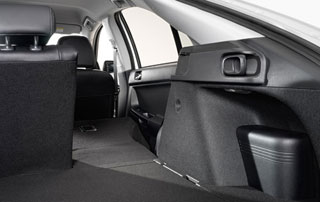
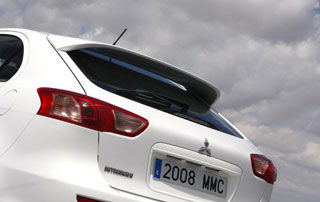
Author: Eunister Wiever
Photo: Mitsubishi
Source: Insideline

